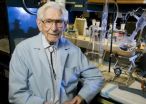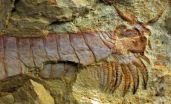(Press-News.org) CHAMPAIGN, Ill. — A 98-year-old researcher argues that, contrary to decades of clinical assumptions and advice to patients, dietary cholesterol is good for your heart – unless that cholesterol is unnaturally oxidized (by frying foods in reused oil, eating lots of polyunsaturated fats, or smoking).
The researcher, Fred Kummerow, an emeritus professor of comparative biosciences at the University of Illinois, has spent more than six decades studying the dietary factors that contribute to heart disease. In a new paper in the American Journal of Cardiovascular Disease, he reviews the research on lipid metabolism and heart disease with a focus on the consumption of oxidized cholesterol – in his view a primary contributor to heart disease.
"Oxidized lipids contribute to heart disease both by increasing deposition of calcium on the arterial wall, a major hallmark of atherosclerosis, and by interrupting blood flow, a major contributor to heart attack and sudden death," Kummerow wrote in the review.
Over his 60-plus-year career, Kummerow has painstakingly collected and analyzed the findings that together reveal the underlying mechanisms linking oxidized cholesterol (and trans fats) to heart disease.
Many of Kummerow's insights come from his relentless focus on the physical and biochemical changes that occur in the arteries of people with heart disease. For example, he has worked with surgeons to retrieve and examine the arteries of people suffering from heart disease, and has compared his findings with those obtained in animal experiments.
He and his colleagues first reported in 2001 that the arteries of people who had had bypass operations contained elevated levels of sphingomyelin (SFING-oh-my-uh-lin), one of several phospholipids (phosphate-containing lipids) that make up the membranes of all cells. The bypass patients also had significantly more oxidized cholesterols (oxysterols) in their plasma and tissues than people who had not been diagnosed with heart disease.
Human cells incubated with the blood plasma of the cardiac patients also picked up significantly more calcium from the culture medium than cells incubated in the plasma of healthy patients. When the researchers added oxysterols to the healthy plasma, the proportion of sphingomyelin in the cells increased, as did the uptake of calcium.
Earlier research, including studies conducted by medical pioneer Michael DeBakey, noted that the most problematic plaques in patients with heart disease occurred at the branch-points of the arteries of the heart. Kummerow followed up on these reports by looking at the phospholipid content of the arterial walls in pigs and humans. He found (and reported in 1994) that the branch points of the arteries in humans and in swine also had significantly more sphingomyelin than other regions of the same arteries.
For Kummerow, the increase in sphingomyelin was a prime suspect in the blocked and calcified arteries of the cardiac patients. He had already found that the arteries of the newborn human placenta contained only about 10 percent sphingomyelin and 50 percent phosphatidylcholine (FOSS-fuh-tih-dul-COH-lean), another important phospholipid component of cell membranes.
"But when we looked at the arteries of people who had had bypass operations, we found up to 40 percent sphingomyelin and about 27 percent phosphatidylcholine," Kummerow said. "It took us many more years to discover that when you added large amounts of oxysterols to the cells, then the phosphatidylcholine changed to sphingomyelin."
Further evidence supported sphingomyelin's starring role in atherosclerosis. When Kummerow and his colleagues compared the blocked and unblocked arteries of patients needing second bypass operations, they found that the arteries with blockages contained twice as much sphingomyelin as the unblocked arteries. The calcium content of the blocked arteries (6,345 parts per million) was also much higher than that of the unblocked arteries (182 ppm).
Other studies had demonstrated a link between increases in sphingomyelin and the deposit of calcium in the coronary arteries. The mechanism by which this occurred was unclear, however. Kummerow's team searched the literature and found a 1967 study that showed that in the presence of certain salts (in the blood, for example), lipids like sphingomyelin develop a negative charge. This explains the attraction of the positively charged calcium to the arterial wall when high amounts of sphingomyelin are present, Kummerow said.
"So there was a negative charge on the wall of this artery, and it attracted calcium from the blood until it calcified the whole artery," he said.
Oxidized fats contribute to heart disease (and sudden death from heart attacks) in an additional way, Kummerow said. He and his collaborators found that when the low-density lipoprotein (LDL, the so-called "bad cholesterol") is oxidized, it increases the synthesis of a blood-clotting agent, called thromboxane, in the platelets.
If someone eats a diet rich in oxysterols and trans fats and also smokes, he or she is endangering the heart in three distinct ways, Kummerow said. The oxysterols enhance calcification of the arteries and promote the synthesis of a clotting agent. And the trans fats and cigarette smoke interfere with the production of a compound, prostacyclin, which normally keeps the blood fluid.
"And that causes 600,000 deaths in this country each year," Kummerow said.
Kummerow is the author of "Cholesterol Won't Kill You, But Trans Fats Could."
INFORMATION:
END EMBARGO FOR RELEASE UNTIL 1 P.M. CST WEDNESDAY (FEB. 27)
Editor's notes: To reach Fred Kummerow, call 217-344-6380.
The paper, "Interaction Between Sphingomyelin and Oxysterols Contributes to Atherosclerosis and Sudden Death," is available online or from the U. of I. News Bureau.
Lipid researcher, 98, reports on the dietary causes of heart disease
2013-02-28
ELSE PRESS RELEASES FROM THIS DATE:
Sitting less and moving about more could be more important than vigorous exercise to reduce your risk of type 2 diabetes
2013-02-28
New research led at the University of Leicester reveals that individuals at high risk of developing type 2 diabetes would benefit from being told to sit less and move around more often- rather than simply exercising regularly. The experts suggest that reducing sitting time by 90 minutes in total per day could lead to important health benefits.
Currently, at risk patients are advised to engage in moderate-to-vigorous physical activity (MVPA) for at least 150 mins per week. But the new study published in Diabetologia (The journal of the European Association for the Study ...
Canadian adult obesity at historic high
2013-02-28
Obesity rates across Canada are reaching alarming levels and continue to climb, according to a new University of British Columbia study.
Published today in the Canadian Journal of Public Health, the study provides the first comprehensive look at adult obesity rates across Canada since 1998, complete with "obesity maps."
"Being obese or overweight significantly increases the risk of chronic illnesses, such as heart disease, diabetes, and some cancers," says study lead author, Prof. Carolyn Gotay in UBC's School of Population and Public Health. "Our analysis shows that ...
How much will I be charged?
2013-02-28
It's a basic, reasonable question: How much will this cost me? For patients in the emergency room, the answer all too often is a mystery.
Emergency departments play a critical role in health care, yet consumers typically know little about how medical charges are determined and often underestimate their financial responsibility -- then are shocked when the hospital bill arrives.
A new study led by UC San Francisco highlights the problem by identifying giant price swings in patient charges for the 10 most common outpatient conditions in emergency rooms across the country.
Out-of-pocket ...
How much protection is enough?
2013-02-28
Protection of marine areas from fishing increases density and biomass of fish and invertebrates (such as lobster and scallops) finds a systematic review published in BioMed Central's open access journal Environmental Evidence. The success of a protected area was also dependent on its size and on how it was managed, however even partial protection provides significant ecological benefits.
Marine ecosystems worldwide are suffering from a loss of biodiversity due to destruction of food chains and habitats. Increasingly areas are being set aside to protect sensitive environments ...
First signs of heart disease seen in newborns of overweight/obese mums
2013-02-28
The walls of the body's major artery - the aorta - are already thickened in babies born to mums who are overweight or obese, finds a small study published online in the Fetal and Neonatal Edition of Archives of Disease of Childhood.
Importantly, this arterial thickening, which is a sign of heart disease, is independent of the child's weight at birth - a known risk factor for later heart disease and stroke.
And it may explain how overweight/obese mums could boost their children's subsequent risk of cardiovascular disease, suggest the authors, who point out that more ...
Every degree fall in winter air temperature equals 1 percent drop in ambulance response time
2013-02-28
[Ambulance call-outs and response times in Birmingham and the impact of extreme weather and climate change Online First doi 10.1136/emermed-2012-201817]
Every one degree fall in outside air temperature during the winter corresponds to a drop in ambulance response time of more than 1 per cent, reveals research published online in Emergency Medicine Journal.
Increased demand and treacherous road conditions during the winter months combine to stretch ambulance services in England, which have a target of reaching 75% of immediately life-threatening (category A) calls within ...
Discovery opens door to multipronged attack against skin common cancer, Stanford study shows
2013-02-28
STANFORD, Calif. — Hailed as a major step forward in the effort to develop targeted cancer therapies, a recently approved drug for the most common type of skin cancer has been a mixed blessing for patients. Although the initial response is usually dramatic, the tumors often recur as the cancer becomes resistant to treatment.
Now researchers at the Stanford University School of Medicine have identified a second way to block the activity of the signaling cascade, called the Hedgehog pathway, that is abnormally active in these cancers. The researchers hope the new approach ...
Feeding limbs and nervous system of one of Earth's earliest animals discovered
2013-02-28
An extraordinary find allowing scientists to see through the head of the 'fuxianhuiid' arthropod has revealed one of the earliest evolutionary examples of limbs used for feeding, along with the oldest nervous system to stretch beyond the head in fossil record.
Until now, all fossils found of this extremely early soft-bodied animal featured heads covered by a wide shell or 'carapace', obscuring underlying contents from detailed study.
But a new fossil-rich site in South China has been found to contain arthropod examples where the carapace has literally been 'flipped' over ...
What is the cost of rare diseases such as Friedreich's Ataxia?
2013-02-28
What is the cost of rare diseases such as Friedreich's Ataxia? By analyzing direct and indirect costs of care research in BioMed Central's open access journal Orphanet Journal of Rare Diseases calculated that conservatively this rare disease costs between £11,000 and £19,000 per person per year. Proper understanding resource allocation is important in minimizing the effect of Friedreich's Ataxia on people's lives while maximizing their quality of life.
Diseases are classified as 'rare' if they affect less than 1 in 2000 people. Lack of scientific knowledge means that ...
IV fluids used by NHS responsible for unnecessary deaths
2013-02-28
Starch-based intravenous (IV) fluids used by the NHS to treat seriously ill patients are causing unnecessary deaths, according to a new Cochrane systematic review by researchers at the London School of Hygiene & Tropical Medicine.
Based on data from 25 randomised control trials, the researchers concluded that starch-based colloid fluids, used to stabilise patients with low blood pressure, are not only more expensive than saline-based crystalloid fluids, but may also be causing around 250 unnecessary deaths in the UK every year.
The study included 9,147 seriously ill ...

